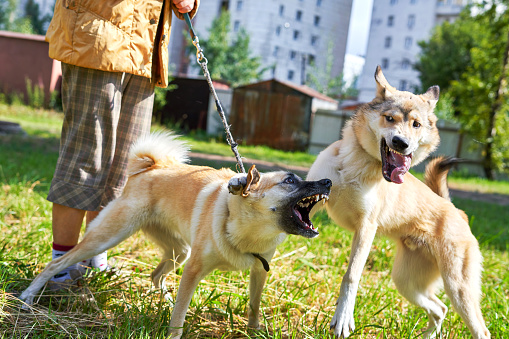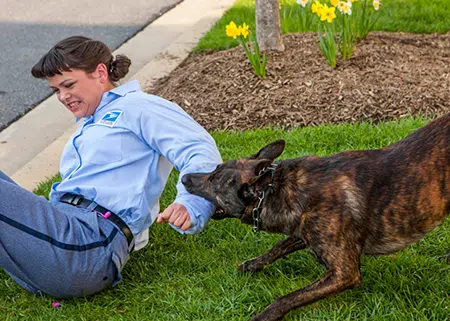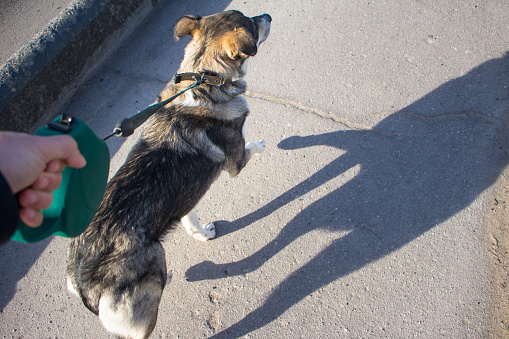
Here are some general tips about how to behave around a dog, followed by recommendations on things you should never do around a dog, many of them provided by the American Veterinary Medical Association.
We also offer some tips from a dog warden and some specific instructions on what to do if a dog attacks you or appears it is about to.
How to avoid owning a dog that bites is also discussed, and a list of several additional dog bite prevention resources is also provided.
How To Behave Around a Dog
- Don’t give a dog a reason to become aggressive or excited. Don’t run past him. He may instinctively chase you.
- Don’t approach a dog with quick motions or pet it on the head. Allow the dog to acknowledge your presence.
- Before contact with a dog, let the dog see you and sniff your closed hand first.
- Don’t approach an unfamiliar dog in its crate, eating, sleeping, chewing on a toy, caring for puppies, or if it is a very old dog. Animals are more likely to bite if they are startled.
- If you see an unknown dog wandering around unsupervised, avoid it, leave the area, and contact animal control or ask an adult to do so.
- Don’t approach a barking or growling dog or one that appears scared. If he is showing his teeth, raising fur along his back or holding his tail high in the air, or staring, he may be about to bite.
- Don’t hug and kiss a dog. This is a major cause of facial bites to children.
- If a dog approaches you and sniffs, stay still. The dog may just be investigating and will go away once it has determined you are not a threat.
- Don’t reach through a fence or into a vehicle to pet a dog. Don’t climb over a fence to get to a dog, even if he is usually friendly. The dog may see this as an attempt to invade its territory and will protect its space. Don’t approach a dog that is tied up.
- Don’t try to break up a fight between dogs or interact with dogs that are play fighting.
Ten “Nevers” for Families and Dogs
- Never try to take something from a dog. What you may interpret as play, the dog may not.
- Never stare at a dog or put your face next to the dog.
- Never escalate a dog attack by yelling, running, hitting, or making sudden movements toward the dog. Try to remain calm.
- Never tease a dog by pulling its ears or tail or climbing on the dog.
- Never select a dog that is not compatible with all family members. Don’t choose an aggressive dog if you have small children. You might consider waiting until your child is about four years old before introducing a dog.
- Never try to “dress up” a dog. The dog may not be comfortable with this type of play.
- Never give a young child too much responsibility in caring for a pet. Monitor their activity to be certain they understand how to complete their tasks.
- Never leave young children or infants unsupervised with a dog. If your child is visiting a home with a dog or dogs, ask what arrangements have been made for the animals and the children.
- Never try to educate children about dogs above a level they can easily understand. With very young children, focus on gentle behavior and what the dogs like and dislike. Help them to develop an understanding of dog behavior as they grow older.
- Never overlook the benefits of reward-based training classes for your puppy. The first time your dog shows aggressive behavior towards anyone, talk to your vet or seek professional help from a Certified Applied Animal Behaviorist (CAAB) or a qualified Certified Professional Dog Trainer (CPDT). Your animal shelter may be able to refer you to such services.
What a Dog Warden Recommends
Dog wardens have many responsibilities in their communities that help to reduce the number of potential dog attack victims. They patrol the streets looking for dogs running at large and unlicensed stray dogs that people have reported to the department. They keep an eye on dogs labeled dangerous and vicious and follow up on dogs in the area that have attacked people or other animals. Dog wardens also can enter private property and seize a dog that its owner is abusing.
Jon Barber, Stark County Dog Warden for the past four years, said it is very important to spay or neuter your dog because it makes them less aggressive and much less likely to bite. He also said it is a good idea to train your dog to feel comfortable around other pets, friends, neighbors, and children and to teach them obedience by having them learn simple commands like “sit,” “stay,” “no,” and “come.”
Stark County currently offers a Bite Avoidance Training Program for elementary school-age children and people who have jobs that put them in at-risk situations when coming into contact with dogs.
Stark County has also posted several other bite prevention tips on the warden’s website:
- Never play aggressively with your dog. The dog may not understand the difference between playtime and real-life situations.
- Don’t put your dog in a situation where it may feel threatened.
- Never approach a dog you don’t know or a dog alone without its owner. If the dog is with its owner, ask the owner for permission to pet it.
- Be cautious if you do not know how your dog will react to a new circumstance. When a person comes to your door, make sure the dog is safely restrained before opening the door. Don’t allow the dog to bark or jump up against the door. This will teach him to “attack” anyone who comes to the door.
- Dog owners can help in dog bite prevention by obeying all leash laws in the community. Do not allow your dog to roam free.
- Keep your dog healthy by having it properly vaccinated and by giving him regular check-ups.
What To Do If A Dog Attack Appears Likely
If you see one or more of the following signals from a dog—tensed body and tail, closed mouth or an open mouth with tight lips, showing of teeth, growling, flicking tongue, raised fur along the back, hard eyes, head back, pulled back ears, furrowed brow, visible whites of the eyes, yawning, an intense stare–it is a good idea to put a safe amount of space between you and the dog and not to turn your back on the dog.
If you are approached by an unknown, hostile dog that may attack you, follow these steps:
• Stop and freeze. Resist the impulse to scream and run toward or run away from the dog. The dog will likely run after you. Instead, “be a tree.” Stand quietly with your hands low and clasped in front of you (the tree’s branches). Avoid eye contact with (staring down) the dog. Remain still and keep your head down looking at your feet (the tree’s roots). Count in your head until the dog loses interest in you, then slowly back away from it.
• If you are knocked to the ground, “become a rock,” by covering your head, neck, and ears with your arms and curling your body into a ball. Protect your face. Remain motionless. Do not scream or roll around.
• If the dog does attack, don’t try to outrun it. Attempt to “feed” the dog your purse or backpack or anything that you can get between yourself and the dog.
• Learn dog body language. Dogs use their whole bodies to speak and in this way, they “talk” to their families telling them when they feel anxious, afraid, threatened, or aggressive. Learning what their bodies are saying will help you learn when to walk away from a dog because he is uncomfortable about something and wants to be left alone. Unruly, unpredictable children rolling around everywhere in a room can be scary to a dog. He is not necessarily having “fun” because the children and their friends are.
Tips to Prevent Owning a Dog that Bites
No one wants to own an aggressive dog. If he or she cannot curtail her bad behavior, it is possible she will have to be removed from the family and “put down.” Here are a few additional tips to prevent this from happening at your home:
- Adopt a well-managed animal shelter whose staff can fill you in on the dog’s background, personality, and behavior in the shelter.
- Make your dog feel like part of your family. Don’t chain it outside, isolated and unsupervised for long periods, even if the yard is fenced.
- Avoid exposing your dog to common triggers of aggression—the approach of strangers, people in uniforms, costumes or unusual attire, unfamiliar places, crowds, loud noises, wind, construction, and fireworks.
Additional Resources for Preventing Dog Bites
On this website, you can find out just about anything you want to know about dog bites. It offers the following and much more:
- A Kids Dog Bite Prevention Animated Video and Illustrated Storybook. These are fun, educational tools that teach children ways to avoid situations where dogs are likely to attack and bite.
- A “Memory” game teaches children how to identify different breeds of dogs. If a dog ever attacks a child, he can better describe it and help authorities locate it.
- A FREE book entitled “When a Dog Bites Fight Back” is a very comprehensive account of what an Ohio dog bite victim needs to know. It contains 11 chapters and can be downloaded, or you can request a hard copy.
- A Dog Bite Prevention and Action Kit
- A Dog Attack Information Sheet
- Blogs on a variety of dog-related topics
- Dog Ordinances and Ohio Dog Laws
- Ohio’s Most Dangerous Dog List
- A video story about a family whose 10-year-old daughter was attacked by a dog and the impact it has had on all of their lives
- Frequently Asked Specific Questions About Dog Bite Cases with Video Answers
- Testimonials from former dog bite victims
Stop The 77
This is a dog bite prevention organization formed by two female dog trainers who have developed a 13-minute musical and other videos aimed at showing young children how to interact with dogs. It also shows parents how to teach these skills. The videos on the site provide simple lessons, mostly about what not to do with the family dog. The site also provides posters children can print and a quiz to take to reinforce the lessons.
The name “Stop The 77” originates from the statistic the dog trainers uncovered, which said that 77% of youngsters attacked by dogs are bitten by the family dog or a friend’s dog.
Many communities in Ohio now also offer dog bite prevention programs in conjunction with Safety Town, a five-day safety education program aimed at children entering kindergarten. Members of the local police and fire department and teachers assist with the effort. Along with learning traffic rules in a model setting, Safety Town participants are taught never to approach a stray dog, never to run from a dog, and many other principles of dog bite avoidance.
Another Very Important Resource
After a dog bite incident, the best resource in many cases is the opportunity to discuss your case with an experienced dog bite lawyer like the attorneys we have at our law firm.
We’ve been helping victims of dog attacks for more than 30 years. Our dog bite lawyers have assisted over 600 dog bite victims throughout the state of Ohio.
Contact us by calling 888.534.4850 to schedule a free and private consultation in person or have one over the telephone. You will get the guidance you need to make the decisions you need to make to take any necessary actions.





